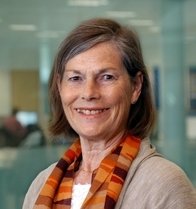Louise Johnson facts for kids
Quick facts for kids
Dame Louise Johnson
|
|
|---|---|
 |
|
| Born |
Louise Napier Johnson
26 September 1940 |
| Died | 25 September 2012 (aged 71) |
| Education | Wimbledon High School for Girls |
| Alma mater | University College London (BSc, PhD) |
| Known for | Discovering the structure of lysozyme and N-Acetylglucosamine |
| Spouse(s) | |
| Awards | Dame Commander of the Order of the British Empire |
| Scientific career | |
| Institutions | University of Oxford |
| Thesis | An X-ray crystallographic study of N-acetylglucosamine and its relation to lysozyme. (1965) |
| Doctoral advisor | David Chilton Phillips |
| Other academic advisors | Frederic M. Richards |
| Doctoral students | David Barford Jenny Martin David J. Owen |
Dame Louise Napier Johnson (born September 26, 1940 – died September 25, 2012) was a brilliant British scientist. She was a biochemist and crystallographer. This means she studied the chemistry of living things and used X-rays to figure out the shapes of tiny molecules. She was a professor at the University of Oxford for many years.
Contents
Early Life and Schooling
Louise went to Wimbledon High School for Girls from 1952 to 1959. Her school encouraged girls to study science and aim for important jobs. Her mother was also a scientist, which helped Louise decide to study science.
In 1959, she started studying Physics at University College London. She was one of only four girls in a class of 40 students. She earned her degree in 1962.
Discovering Molecule Shapes
During a holiday, Louise worked at the Atomic Energy Authority. There, she met Uli Arndt, a scientist who used a method called neutron diffraction. This method helps scientists understand the structure of materials.
In 1962, Louise moved to the Royal Institution to earn her PhD in biophysics. Her supervisor was David Chilton Phillips. His team was working to find the structure of a protein called lysozyme.
Her first task was to figure out the shape of a sugar molecule called N-Acetylglucosamine. She used X-ray crystallography, which is like taking an X-ray picture of a molecule. She solved this puzzle in just one year.
After that, she helped the team discover the structure of the enzyme lysozyme. This was a huge achievement! It was only the third protein structure ever solved using X-ray crystallography, and the first enzyme. She received her PhD in 1965.
Research and Teaching Career
After her PhD, Louise went to Yale University in 1966 for more research. She worked with Frederic M. Richards on another enzyme called ribonuclease.
In 1967, she returned to the UK and started working at the University of Oxford. She taught and continued her research on lysozyme and other enzymes.
Unlocking Glycogen Phosphorylase
In 1972, Louise received crystals of a very important enzyme called glycogen phosphorylase. This enzyme was much larger than lysozyme. It was also bigger than any other protein whose structure had been solved at that time. This marked the start of a major part of her research.
By 1978, her team had discovered its structure. They then worked to understand how it is controlled in the body. Glycogen phosphorylase is found in muscles. It helps turn stored energy (glycogen) into fuel for muscle movement.
Her research helped explain how this enzyme switches on and off. This is important for providing energy when muscles need it. Her team used a powerful X-ray source called the Synchrotron Radiation Source to get their data.
Leadership at Oxford
From 1990 to 2007, Louise Johnson was the David Phillips Professor in Molecular Biophysics at the University of Oxford. Her lab solved and studied many other protein structures. She helped train many future scientists who now lead research around the world.
She also co-wrote an important textbook about protein crystallography. From 2003 to 2008, she was the Director of Life Sciences at Diamond Light Source. This is the UK's national synchrotron facility.
Awards and Recognition
Louise Johnson received many honors for her amazing work.
- In 2003, she was made a Dame Commander of the Order of the British Empire (DBE).
- She was a Fellow of Corpus Christi College, Oxford and an Honorary Fellow of Somerville College, Oxford.
- She received honorary degrees from several universities, including University of St Andrews, University of Bath, Imperial College London, and University of Cambridge.
- In 1990, she was elected a Fellow of the Royal Society (FRS). This is a very high honor for scientists in the UK.
- She also became a Foreign Associate of the US National Academy of Sciences in 2011.
Personal Life
Louise Napier Johnson was born on September 26, 1940, in Worcester, England. She was the second of three daughters. Her father was a wool broker who served in the Royal Air Force.
In 1968, Louise married Abdus Salam, a theoretical physicist from Pakistan. He later won the Nobel Prize for Physics in 1979. They had two children, a son born in 1974 and a daughter born in 1982. Louise's husband passed away in 1996. She died on September 25, 2012, in Cambridge, England, at the age of 71.
See also
 In Spanish: Louise Johnson para niños
In Spanish: Louise Johnson para niños

